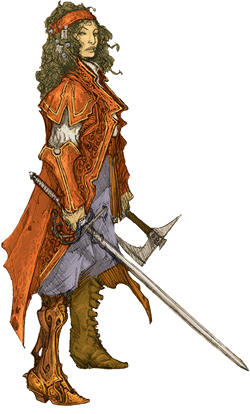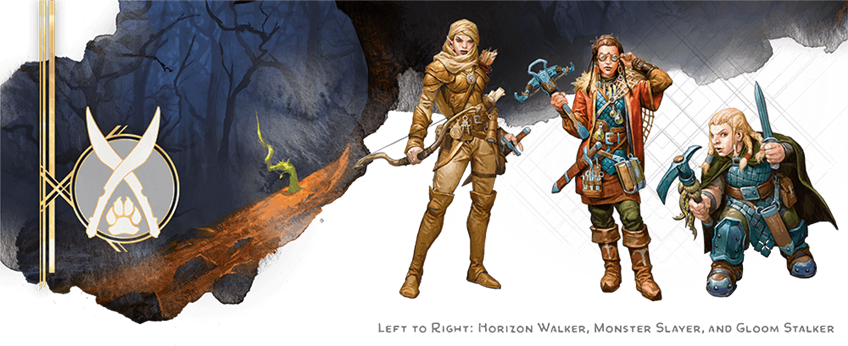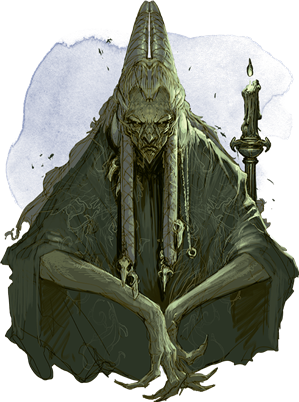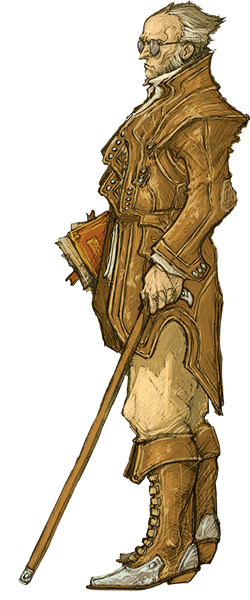 Earlier this month, you journeyed to a Haunted Cornfield and fought a horrifying monster. All D&D characters are well-equipped to battle monsters, but one class archetype is particularly themed around hunting down and destroying evil creatures. And the “hunting” part is important—because this class archetype is the Monster Slayer ranger, known during playtesting as the Monster Hunter. If you’re planning on playing a special Halloween-themed game of D&D this month, and you want to be an archetypal monster hunter like Van Helsing (Dracula) or Simon Belmont (Castlevania), then this ranger archetype is your best friend.
Earlier this month, you journeyed to a Haunted Cornfield and fought a horrifying monster. All D&D characters are well-equipped to battle monsters, but one class archetype is particularly themed around hunting down and destroying evil creatures. And the “hunting” part is important—because this class archetype is the Monster Slayer ranger, known during playtesting as the Monster Hunter. If you’re planning on playing a special Halloween-themed game of D&D this month, and you want to be an archetypal monster hunter like Van Helsing (Dracula) or Simon Belmont (Castlevania), then this ranger archetype is your best friend.
Emulating Monsters Slayers from Fiction
Before examining its mechanics, let’s dive into the thematic heart of this subclass. We already took a quick look at it back in September as part of Ranger 101, but we have the chance to go a little deeper into how you can roleplay a Monster Slayer successfully. Xanathar’s Guide to Everything has this to say about Monster Slayers:
You have dedicated yourself to hunting down creatures of the night and wielders of grim magic. A Monster Slayer seeks out vampires, dragons, evil fey, fiends, and other magical threats. Trained in supernatural techniques to overcome such monsters, slayers are experts at unearthing and defeating mighty, mystical foes.
This sounds great, but how do you play a character like this? A Monster Slayer is wholly devoted to destroying monsters—or even one monster in particular. In Greek myth, Perseus was given a quest to slay the gorgon Medusa, and he was forced use magic and his wits to not only kill his quarry, but also to track her to her lair first. Greek mythology is replete with monster slayer following a quest to kill a singular creature: Theseus stalked and killed the Minotaur, Bellerophon fought the Chimera after taming Pegasus, and so on.
But the Monster Slayer of D&D is interested in not just hunting a single monster, but in evil monsters as a broad group of creatures. Your Monster Slayer’s story may begin with hunting a single creature, but perhaps upon succeeding in your first quest, you gain a taste for destroying evil, and continue to search after greater and greater threats. To draw once more upon Greek mythology, perhaps your character is more like Herakles, who undertook twelve great labors—several of which involved slaying monsters like the Nemean lion, the Hydra, and capturing Cerberus, three-headed hound of the Underworld.
There is one literary source that produces an endless flood of monster hunters: the story of Dracula. As stated above, Abraham Van Helsing may be the ur-monster hunter in Gothic fiction. While Bram Stoker’s original novel painted Van Helsing as simply a doctor who possessed incredible and diverse knowledge (which happened to extend into the occult), in Dracula (1958), Peter Cushing portrayed Van Helsing as not merely a well-traveled doctor, but a vampire hunter by trade. The idea of Van Helsing as vampire hunter was pushed even further in Van Helsing (2004), in which Hugh Jackman portrayed the eponymous monster hunter battling not just Dracula, but the entire rogues’ gallery of classic horror: Victor Frankenstein and his Monster, the Wolfman, Mr. Hyde, and so forth.
This kitchen-sink Gothic horror incarnation of Van Helsing is not unlike Simon Belmont in Castlevania for the Nintendo Entertainment System (1986). Simon Belmont is a heroic son of the Belmont clan, a family of monster hunters tasked with killing Dracula when he is resurrected once every century. In this lighthearted and cheesy tribute to classic horror, Belmont battled mummies, vampire bats, Frankenstein’s monster, Medusa, and even Death himself on the way to battle Dracula. Even though Belmont’s primary goal was to slay Dracula, his quest brought him in contact with countless monsters to slay.
These are just a few of the countless monster slaying heroes throughout history, but remember: the archetypal Monster Slayer devotes their life to hunting monsters. They also are aided by mystical power. Belmont certainly qualifies, with his bevy of enchanted weapons, and many Greek heroes had magical or divine aid. Van Helsing is a scientist, but he is described in the novel Dracula as both a philosopher and a metaphysician—one who deals with the spiritual, and perhaps even the occult.

Your Archnemesis
 Looking back at these great slayers of monsters, notice how many of them have a single quarry that they wish to kill. Dracula, the Minotaur, Medusa, and so on. While these heroes battle many other monsters during their quest, they are constantly motivated by a need to slay their one true quarry. Whether this is for love, to fulfill a destiny or prophecy, or simply to exact revenge—that choice is up to you. Just know that having a singular quarry—an archnemesis—can help ground your character and give you a better understanding of how to play them consistently. This often plays into your backstory; a monster killed a family member, or you are cursed and must kill the being that cursed you, or your family has a destiny to destroy a creature… and so on.
Looking back at these great slayers of monsters, notice how many of them have a single quarry that they wish to kill. Dracula, the Minotaur, Medusa, and so on. While these heroes battle many other monsters during their quest, they are constantly motivated by a need to slay their one true quarry. Whether this is for love, to fulfill a destiny or prophecy, or simply to exact revenge—that choice is up to you. Just know that having a singular quarry—an archnemesis—can help ground your character and give you a better understanding of how to play them consistently. This often plays into your backstory; a monster killed a family member, or you are cursed and must kill the being that cursed you, or your family has a destiny to destroy a creature… and so on.
And what happens when you defeat your archnemesis? What happens when Batman defeats the Joker, or Superman defeats Lex Luthor? Those superheroes have a full rogues’ gallery of other villains to battle; your Monster Slayer may turn their attention to another nemesis and continue battling as normal. That’s a perfectly valid. If you just want to play D&D and don’t want to come up with an excuse, then don’t worry about it. You like hunting monsters. That’s fine.
On the other hand, it could be fun to follow your motivation through to its natural conclusion. You got what you wanted. What would you do if you got everything you’ve ever wanted? Would you retire happily? Or would you fall into a depression, now that your life’s ambition has been completed? You might continue going through the motions of your old life, finding greater and greater challenges… but it just doesn’t satisfy you in the way it once did. If you’ve avenged your son’s death (for example) by slaying the werewolf who killed him, continuing to kill still won’t bring him back.
This is a deep well of character inspiration. Keep it in your back pocket, just in case you and your group want to explore a more melancholy vein of fantasy.
Playing a Monster Slayer
 Let’s dive into the mechanics of playing a Monster Slayer. Rangers have a lot of out of combat utility built into their core class, so it stands to reason that the Monster Slayer archetype is heavily combat-oriented. You aren’t just a damage machine like the Hunter archetype, though. You actually have a very tactical skill set, and the bonus spells you get at 3rd, 5th, 9th, 13th, and 17th levels don’t hurt, either.
Let’s dive into the mechanics of playing a Monster Slayer. Rangers have a lot of out of combat utility built into their core class, so it stands to reason that the Monster Slayer archetype is heavily combat-oriented. You aren’t just a damage machine like the Hunter archetype, though. You actually have a very tactical skill set, and the bonus spells you get at 3rd, 5th, 9th, 13th, and 17th levels don’t hurt, either.
Building a Monster Slayer is pretty straightforward. The expanded quick build guide in Ranger 101 provides a solid baseline. Beyond the basics, the Monster Slayer strikes a solid balance between martial combat and magical power. You’ll want to invest equally in Strength-or-Dexterity and Wisdom to make the most of your Monster Slayer powers. In early levels, you’re incredibly valuable as an offensive fighter thanks to your Slayer’s Prey feature, which you gain at 3rd level. Use this feature as often as possible; you may wish to invest in a weapon like a longsword or longbow rather than dual wielding, since you need your bonus action to initially activate this feature.
But you also gain powerful defensive and tactical tools at 3rd level, too. Protection from evil and good is a powerhouse against certain types of monsters common to horror settings, like undead and fiends, and your Hunter’s Sense feature helps you learn how to fight monsters you don’t know anything about by revealing their damage immunities, resistances, or vulnerabilities. It’s a great way to have a Van Helsing moment in the midst of combat—you know so much about fighting monsters, you just have to remember how… aha! Werewolves abhor silver!
Picking up zone of truth at 5th level is a neat trick, and it feels quite thematic. It lets you hunt monsters not just by tracking them like all rangers can, but by interrogating them. The monsters you hunt may not even be hideous beasts, but regular, everyday monsters like corrupt clergy. There’s no shortage of corrupt clerics in the Netflix Castlevania series (2017), for inspiration.
Your 7th-level feature, Supernatural Defense, helps round out your defensive toolkit by making it easier to escape grapples initiated by the target of your Slayer’s Prey feature. It’s niche, but it has its uses. Again, it’s also a very thematic ability. Grappling for your life against a hideous monster is very classic horror.
Gaining magic circle at 9th level lets you ward your entire party against supernatural intruders. It harkens to scenes of warding a house with droplets of holy water… or even alluding back to the Old Testament ritual of Israelites painting a sigil in lamb’s blood upon the doorpost so that God’s final plague would pass over their house.
Your 11th-level feature, Magic-User’s Nemesis makes Monster Slayers incredible magic-hunters as well. With a few minor differences, it essentially grants you the power to cast counterspell once per short rest without expending a spell slot. It also affects non-spell-based teleportation effects, which could have some niche applications.
At 13th level, you gain the spell banishment, which has potent offensive and defensive uses. Against creatures like fiends, it is an incredibly powerful spell, especially against solo boss monsters. If you can maintain your concentration for the spell’s full 1 minute duration, the fiend is permanently banished back to its home plane, effectively negating a huge part of an encounter. Even if the target isn’t a supernatural being, or even if you can’t maintain concentration the whole time, removing a creature from the encounter even temporarily is a huge swing in your party’s favor.
Your final feature, gained at 15th level, is Slayer’s Counter, and it allows you to make a weapon attack against the target of your Slayer’s Prey as a reaction when it forces you to make a saving throw. Not just a melee weapon attack, but any weapon attack. If the attack hits, your save automatically succeeds! And you can do this as many times per rest as you want, as long as you can spend the reaction. This ability isn’t always active, but it can be an absolute powerhouse when it comes into play.
Your last bonus spell, hold monster, is a fitting capstone for this archetype. While it isn’t as flashy as some of your other features, it’s a straightforward and powerful spell.
Playing a Monster Slayer Your Way
How will you play a Monster Slayer ranger this Halloween? Will you be hunting Strahd in the halls of Castle Ravenloft? Or will you be searching fetid marshes for Tiamat’s black dragon spawn? Will you be striding across the planes, hunting devils? Monster Slayers have incredibly diverse skills, but their motivations and backgrounds are just as varied. This Halloween, consider playing a character that makes you feel like a powerful and mythic hero, destined to destroy evil.
 James Haeck is the lead writer for D&D Beyond, the co-author of Waterdeep: Dragon Heist and the Critical Role Tal'Dorei Campaign Setting, the DM of Worlds Apart, and a freelance writer for Wizards of the Coast, the D&D Adventurers League, and Kobold Press. He lives in Seattle, Washington with his partner Hannah and his little mousie slayers, Mei and Marzipan. You can usually find him wasting time on Twitter at @jamesjhaeck.
James Haeck is the lead writer for D&D Beyond, the co-author of Waterdeep: Dragon Heist and the Critical Role Tal'Dorei Campaign Setting, the DM of Worlds Apart, and a freelance writer for Wizards of the Coast, the D&D Adventurers League, and Kobold Press. He lives in Seattle, Washington with his partner Hannah and his little mousie slayers, Mei and Marzipan. You can usually find him wasting time on Twitter at @jamesjhaeck.








-
View User Profile
-
Send Message
Posted Oct 10, 2018Making one now ! Thanks for the insight and inspiration!
-
View User Profile
-
Send Message
Posted Oct 10, 2018Awesome! Monster Slayer's my fave of all ranger archetypes, gotta build one now. Many thanks for your insights James!
-
View User Profile
-
Send Message
Posted Oct 10, 2018When picking between Monster Slayer and Colossal Slayer Hunter I always felt it edged towards Hunter but this is pretty good insight into the cool spell benefits that the subclass can bring to the table.
-
View User Profile
-
Send Message
Posted Oct 10, 2018Wow. Before, I wasn't really sure what a Monster Slayer Ranger was supposed to be, but now I can totally see someone with a journal of notes about every monster they face, and someone who fights methodically with an ultimate goal in mind. I love it!
-
View User Profile
-
Send Message
Posted Oct 10, 2018Its funny this coming out, i just finished a monster hunter build idea last week, as a hunter of evil mages, natural or otherwise
-
View User Profile
-
Send Message
Posted Oct 11, 2018dank
-
View User Profile
-
Send Message
Posted Oct 11, 2018Supernatural defense is a lot better than this implies. It works on saving throws as well as grapples, making it amazing for resisting things like petrification, fear, or charms.
-
View User Profile
-
Send Message
Posted Oct 11, 2018Came for the article; stayed for the Curse of Strahd art <3
-
View User Profile
-
Send Message
Posted Oct 11, 2018Truth be told, depending on the monster you're tracking, Gloomstalker actually does it better. However, Monster Slayer abilities are nothing to be sneezed at, in particular the bonus vs Saves and Grapples.
-
View User Profile
-
Send Message
Posted Oct 11, 2018Personally i actually made a Simon Belmont inspired character using a Paladin of Vengeance as a base class and then multiclassing into Hexblade with a whip as its focus. Whip smites, hex bonuses, pact of the blade, its brilliant. This is great too though! Really wondering about trying them both out.
-
View User Profile
-
Send Message
Posted Oct 11, 2018I'm playing a Monster Slayer right now and I love it. She's halfling with a crossbow and Slayer's Prey has made her a powerhouse in combat. Thanks for the great article!
-
View User Profile
-
Send Message
Posted Oct 13, 2018Cool that also sounds a lot like Geralt of Rivia to me! Just need to pack in a variety of potions to drink and poison my weapons and a bunch of cool, uncompromising phrases to fear my enemies 😎
-
View User Profile
-
Send Message
Posted Oct 14, 2018"Your 7th-level feature, Supernatural Defense, helps round out your defensive toolkit by making it easier to escape grapples initiated by the target of your Slayer’s Prey feature. It’s niche, but it has its uses."
Yeah I think you left off that huge thing about it applying to all saving throws caused by the creature... Spells, poisons, physical impairments. It's relevant to basically every non-minion monster in existence.
-
View User Profile
-
Send Message
Posted Oct 15, 2018You can make Geralt essentially with Matthew Mercer's Blood Hunter class.
-
View User Profile
-
Send Message
Posted Oct 16, 2018Admittedly, I think a straight Fighter works better for <insert current generation here> Belmont (at least in the NES/SNES era games, I haven't kept up with newer stuff as much as I'd like). I mean, he just hits things until they fall down or explode or whatever. I figure Champion Fighter fits best, especially since Natural Athlete is a nice nod to the platforming parts of the gameplay.
-
View User Profile
-
Send Message
Posted Aug 3, 2020During the quarantine, my girlfriend and I binge-watched the TV show "Grimm," so when we joined a Curse of Strahd campaign, her first thought was "I want to play a Grimm!"
And so now she will be playing a monster slayer.